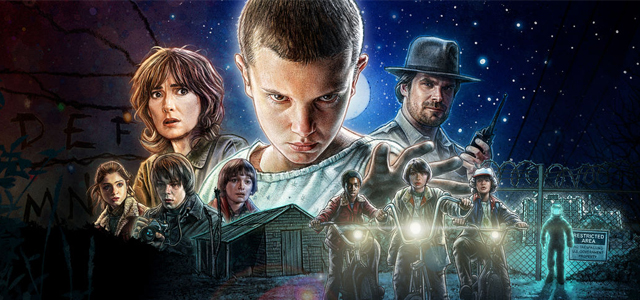(M) Matthew Modine, Winona Ryder
Now streaming all episodes on Netflix
The recent premiere of the Netflix produced series Stranger Things is a throwback and homage to ’80s cinema and clearly has been inspired by the work of seminal filmmakers of that period. It harks back to the sparse scares of science fiction in the decade built on the genre cinema of Spielberg, Cronenberg and Lynch – as well as no small amount of Stephen King.
Taking place in small-town Indiana, 1983, the setting of Stranger Things is as much its fabric as it is its scenario. The accuracy with which Stranger Things’ writers and creators — The Duffer Brothers — recreate not just the body, but the soul of works such as E.T., The Goonies, The Gate, Close Encounters of the Third Kind, Scanners and IT, goes beyond any simple observation of visual style.
The series is about a group of preteens — mostly boys — who encounter something slightly terrifying (all the better to reference the canon of 80s films from Speilberg). In this case, the slightly terrifying “something” is a strange monster that comes from an alternate dimension the kids call the “Upside Down.” The monster captures one of them in the first 15 minutes of the first episode, and the rest of the season deals with trying to rescue him.
The central kids are pretty stock standard best friends. And of course there’s a girl. But in keeping with the genre, the girl has superpowers and is the only person in town who can stop the monster.
The star of Stranger Things — if such an ensemble-heavy show can be said to have a star — is Winona Ryder as Joyce, the single mother of a boy who’s been captured by the titular monster of the series. She’s valiantly trying to raise two kids on her own; all the better to channel Spielberg’s E.T.
Over the eight episode arc the series boasts something of a melancholy soul, one that’s most potent when these two are sharing the screen. That melancholy feeling is what elevates the show beyond its homages, to something approaching real feeling.
If nothing else, the Duffers have a real talent for coming up with gorgeous images that will stick in your imagination. Like Joyce’s attempts to decorate the house with Christmas lights to contact the supernatural powers she believes may have taken her child. Like the scene in ET where Henry camps out in the yard waiting for ET to surface, the series blends the weird with the mundane, in a way that pays true credit to how thoroughly they’ve digested their obvious inspirations.
Perhaps it may also be the series’ spiritual undertones which have also given it some universal appeal.
As Relevant magazine in the US has recently suggested in its post The Gospel According to Stranger Things , “The world of Stranger Things resembles the Christian understanding of our world. It has two interconnected dimensions: The first is the idyllic world of the 1980’s, filled with nostalgia that almost immediately causes viewers long for a simpler time. The second is the Upside Down. It’s described as a world of death … This world heavily recalls the Christian understanding of our world: On one level, the world is beautiful because it’s God’s creation; but on another, it’s terrifying because of its fallen state.”
Whatever you think about the series allusions to Christianity and comparisons to draw, Stranger Things sees several disparate groups variously drawn into a wider, darker world than they’ve ever known before. They are forced to define themselves by how they choose to explore it and overcome its dangers.
Adrian Drayton





